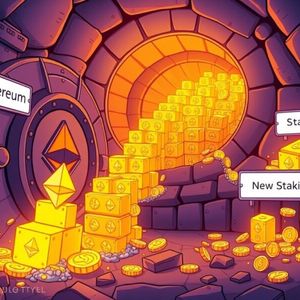BitcoinWorld Ethereum Unstaking: Unveiling the Critical $2.5 Billion Exodus on the PoS Network The world of cryptocurrency is always buzzing with activity, and right now, all eyes are on the Ethereum network. A staggering figure has emerged from the depths of on-chain analytics: over $2.5 billion in ETH is currently queued for Ethereum unstaking . This massive movement of capital isn’t just a number; it’s a significant indicator of market dynamics, investor sentiment, and the evolving maturity of the Ethereum Proof-of-Stake (PoS) ecosystem. For anyone invested in or curious about the future of decentralized finance, understanding this trend is absolutely critical. Unveiling the Scale of Ethereum Unstaking: What’s Happening? According to data from the on-chain analytics platform, Validator Queue, approximately 655,033 ETH , valued at an astounding $2.53 billion , is currently sitting in the unstaking queue on the Ethereum PoS network. This represents a substantial portion of the total staked ETH and signals a significant shift in the network’s staking landscape. To put this into perspective, imagine a vast digital vault, and a considerable amount of its contents are now being requested for withdrawal. Interestingly, while a large sum is leaving the staking pool, there’s also a continuous influx of new capital. At the same time, around 257,943 ETH , worth approximately $997.86 million , is awaiting new staking. This dual movement—large outflows and significant inflows—paints a complex picture of a dynamic market where participants are constantly re-evaluating their positions and strategies. This phenomenon isn’t entirely unexpected. Following the monumental Shanghai (Shapella) upgrade in April 2023, which enabled withdrawals of staked ETH for the first time, the network gained a crucial layer of liquidity. Before this upgrade, ETH staked on the Beacon Chain was locked indefinitely, a major concern for many potential stakers. The ability to unstake has transformed Ethereum’s PoS model, making it more flexible and appealing to a broader range of participants. Why Are Investors Opting for Ethereum Unstaking? The decision to unstake ETH is multi-faceted, driven by a combination of market conditions, individual financial goals, and evolving investment strategies. Several key factors contribute to the current surge in Ethereum unstaking requests: Profit-Taking: Ethereum’s price has seen significant appreciation over various periods. For early stakers who locked their ETH when prices were lower, unstaking now allows them to realize substantial gains. This is a natural cycle in any bull market. Portfolio Rebalancing: Investors often rebalance their portfolios to manage risk or allocate capital to other opportunities. Unstaking ETH provides the liquidity to diversify into other cryptocurrencies, traditional assets, or even new DeFi protocols. Exploring New Opportunities: The crypto ecosystem is vast and ever-evolving. New Layer 2 solutions, alternative PoS chains, and innovative DeFi applications constantly emerge, offering potentially higher yields or different risk profiles. Unstaking ETH frees up capital to explore these avenues. Addressing Liquidity Needs: For some, the initial lock-up period was a deterrent. Now that liquidity is available, individuals or institutions might unstake to meet operational costs, respond to personal financial needs, or simply have access to their capital. Market Uncertainty: Despite bullish trends, the crypto market remains volatile. Some investors might be taking profits or reducing exposure due to broader macroeconomic concerns or specific market signals, preferring to hold liquid ETH or stablecoins. Understanding the Mechanics: How Does Ethereum Unstaking Work? The Ethereum PoS network handles unstaking requests through a well-defined process to maintain network stability and security. It’s not an instant withdrawal, which is crucial for preventing sudden shocks to the system. Here’s a simplified breakdown: Withdrawal Queue: When a validator initiates a withdrawal, their request enters a queue. The length of this queue depends on the number of active validators and the overall network activity. This mechanism prevents a “bank run” scenario. Processing Rate: The network processes withdrawals at a controlled rate, typically around 16 withdrawals per epoch (every 6.4 minutes). This rate adjusts dynamically based on the number of active validators. Partial vs. Full Withdrawals: Partial Withdrawals: These automatically sweep rewards (accumulated ETH beyond the 32 ETH required for staking) from active validators. These are processed more frequently and don’t require exiting the validator set. Full Withdrawals: These involve exiting the validator set entirely and withdrawing the initial 32 ETH principal along with any remaining rewards. This process requires the validator to be “exited” from the network, which also goes through a queue. The current queue length for full withdrawals is what Validator Queue tracks, indicating the time it takes for a validator to fully exit and receive their staked ETH. While the current queue of over $2.5 billion ETH sounds large, the system is designed to handle it without compromising network integrity. The Impact of Ethereum Unstaking on the Network Such a significant volume of Ethereum unstaking naturally raises questions about its potential impact on the network’s health and market dynamics. Let’s explore some key areas: Market Supply and Price Action: A large amount of ETH becoming liquid could, in theory, increase selling pressure if a significant portion of unstaked ETH is immediately sold. However, the presence of a substantial “new staking” queue suggests that much of this ETH might be re-staked, moved to liquid staking protocols, or used in DeFi, rather than immediately sold. The market has largely absorbed previous unstaking events without major price crashes. Network Security and Decentralization: The security of the Ethereum PoS network relies on a robust number of active validators. While some validators are exiting, the continuous inflow of new stakers ensures that the overall number of active validators remains healthy, maintaining the network’s security and decentralization. A diverse set of stakers, rather than just a few large entities, is crucial for decentralization. Staking Yields: As the total amount of staked ETH fluctuates, so too can staking yields. If a large amount of ETH is unstaked without being replaced, the yield for remaining stakers might theoretically increase (due to fewer stakers sharing rewards). Conversely, if new staking outpaces unstaking, yields could slightly decrease. These are dynamic factors that market participants constantly monitor. Investor Sentiment: The ability to unstake ETH has largely been viewed as a positive development, enhancing trust and liquidity in the Ethereum PoS ecosystem. While large queues might appear daunting, they are also a testament to the system working as intended, processing withdrawals in an orderly fashion. Is This Exodus a Concern or a Sign of Maturity for Ethereum Staking? The headline figure of over $2.5 billion in Ethereum unstaking can evoke different reactions. Is it a red flag, signaling a loss of confidence, or a natural progression for a maturing blockchain network? From one perspective, a large unstaking queue might raise concerns about potential selling pressure on the ETH price. If all this unstaked ETH were to hit the open market simultaneously, it could indeed lead to significant volatility. However, as discussed, the network’s queue mechanism and the observed re-staking behavior mitigate this risk. More optimistically, this activity is largely a sign of the Ethereum network’s growing maturity and robust design. The Shanghai upgrade delivered on its promise of liquidity, making staking a more flexible and attractive option. The ability to withdraw removes a major barrier to entry for institutional investors and larger funds who prioritize liquidity. It signifies that the market is healthy enough to allow capital to flow in and out, responding to market conditions and investor preferences, much like any other mature financial market. The fact that new ETH is continuously being staked, even as significant amounts are unstaked, demonstrates ongoing confidence in Ethereum’s long-term value proposition and its role as the backbone of the decentralized web. It suggests a dynamic equilibrium where capital is efficiently allocated based on individual strategies rather than a mass exodus. Looking Ahead: The Future of Ethereum Staking The current dynamics around Ethereum unstaking provide valuable insights into the future trajectory of the network’s staking ecosystem. We can anticipate several trends: Growth of Liquid Staking Solutions: Protocols like Lido, Rocket Pool, and others that offer liquid staking derivatives (LSDs) will likely continue to grow. These solutions provide the benefits of staking (yields) while maintaining liquidity, making them increasingly attractive. Institutional Adoption: As the network matures and liquidity concerns are addressed, more institutional players are expected to enter the Ethereum staking arena, drawn by stable yields and the fundamental role of Ethereum in Web3. Evolving Staking Infrastructure: The tools and services supporting Ethereum staking will become more sophisticated, catering to diverse needs from individual stakers to large enterprises. Network Upgrades and Efficiency: Future Ethereum upgrades will likely focus on further enhancing network efficiency, scalability, and potentially optimizing staking mechanisms, making the process even smoother and more accessible. Actionable Insights for Ethereum Investors For those navigating the Ethereum ecosystem, here are some actionable insights based on the current unstaking trends: Monitor On-Chain Data: Keep an eye on platforms like Validator Queue to understand the real-time dynamics of staking and unstaking queues. This data can offer insights into market sentiment and potential supply changes. Understand Your Risk Tolerance: Before staking or unstaking, assess your personal financial goals and risk tolerance. Staking offers rewards but involves locking up capital for a period. Explore Liquid Staking: If liquidity is a primary concern, consider liquid staking protocols. They allow you to earn staking rewards while retaining the ability to trade or use your staked assets (via their derivative tokens) in other DeFi applications. Diversify Your Portfolio: Don’t put all your eggs in one basket. While Ethereum is a robust asset, a diversified portfolio can help mitigate risks. Stay Informed: The crypto space evolves rapidly. Continuously educate yourself on network upgrades, market trends, and regulatory developments that could impact your Ethereum holdings. In conclusion, the substantial queue for Ethereum unstaking , while a headline-grabbing figure, is fundamentally a sign of a healthy, maturing Proof-of-Stake network. It underscores the success of the Shanghai upgrade in delivering crucial liquidity and highlights the dynamic nature of capital flow within the crypto economy. As Ethereum continues to solidify its position as a foundational blockchain, these movements reflect a robust ecosystem adapting to the needs of its diverse participant base, poised for continued innovation and growth. Frequently Asked Questions (FAQs) Q1: What is Ethereum unstaking? A1: Ethereum unstaking refers to the process of withdrawing previously staked ETH (and any accumulated rewards) from the Ethereum Proof-of-Stake (PoS) network. Staking involves locking up ETH to help secure the network and earn rewards, and unstaking allows participants to retrieve their funds. Q2: Why is there a queue for Ethereum unstaking? A2: Ethereum has a withdrawal queue mechanism to manage the flow of ETH out of the staking contract in an orderly manner. This prevents sudden large withdrawals from destabilizing the network and ensures network security by controlling the rate at which validators can exit. Q3: Does a large unstaking queue mean people are losing faith in Ethereum? A3: Not necessarily. While some unstaking might be due to profit-taking or rebalancing, a large queue also indicates the system is working as intended post-Shanghai upgrade, providing liquidity. It’s often seen as a sign of maturity, allowing investors flexibility, and new ETH is also constantly being staked. Q4: How long does it take to unstake ETH? A4: The time it takes to unstake ETH depends on the length of the withdrawal queue. This queue’s size fluctuates based on network activity. On-chain analytics platforms like Validator Queue provide real-time estimates for wait times. Q5: What are the main reasons for the current wave of Ethereum unstaking? A5: Key reasons include profit-taking after price appreciation, portfolio rebalancing, seeking new investment opportunities in DeFi or other chains, and simply accessing liquidity that was previously locked. It’s a natural market behavior in a liquid environment. Q6: How does Ethereum unstaking impact staking yields? A6: Staking yields are dynamic. If a significant amount of ETH is unstaked without being replaced by new stakers, the yield for the remaining stakers might slightly increase. Conversely, if new staking outpaces unstaking, yields could see a slight decrease. It’s a balance of supply and demand for staking slots. If you found this article insightful, consider sharing it with your network! Help us spread awareness about the fascinating dynamics of the Ethereum network and its evolving Proof-of-Stake ecosystem by sharing on your favorite social media platforms. To learn more about the latest Ethereum trends, explore our article on key developments shaping Ethereum price action . This post Ethereum Unstaking: Unveiling the Critical $2.5 Billion Exodus on the PoS Network first appeared on BitcoinWorld and is written by Editorial Team













